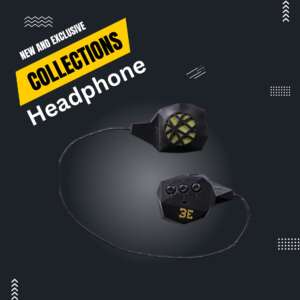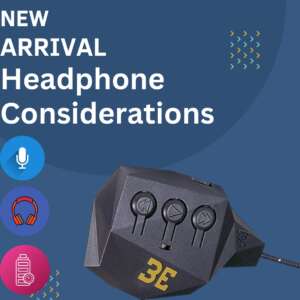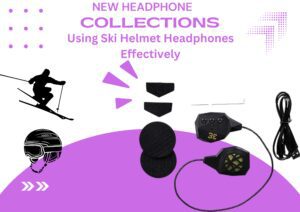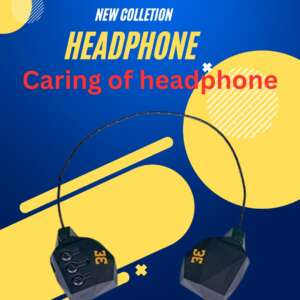Skiing while enjoying your favorite music or podcasts can enhance your experience on the slopes. However, it’s essential to prioritize safety and comfort when using headphones on the ski hill. Here’s an unconventional guide to ski helmet headphones.
In the adrenaline-pumping world of skiing, where breathtaking descents and exhilarating slopes reign supreme, the harmony of music meets the thrill of the outdoors through an unconventional companion: helmet Rlx headphones.
This guide unveils an innovative way to elevate your skiing experience, blending the rhythmic beats of your favorite tunes with the majestic beauty of snow-covered mountains.
As skiing evolves to embrace technology, the marriage of safety gear and entertainment becomes seamless with these helmet-integrated headphones.
Beyond the standard auditory experience, these silver headphones represent a fusion of convenience, safety, and musical enjoyment, revolutionizing how skiers connect with their surroundings.
Imagine carving your way down the slopes, the crisp mountain air filling your lungs as your skis glide over the snow, all while your ears are serenaded by your chosen soundtrack.
Choosing the Right Ski Helmet Headphones
When it comes to hitting the slopes, music can be the ultimate companion, turning an already exhilarating skiing experience into an even more memorable one.

Enter helmet headphones, a fusion of technology and adventure that allows you to groove to your favorite tunes while carving through the snow-covered mountains.
However, selecting the right pair of Vivitar headphones for this purpose isn’t as straightforward as grabbing any old set off the shelf. This unconventional guide will navigate you through the key considerations for choosing the perfect ski headphones.
Weather Resistance and Durability:
Skiing exposes you to a wide range of weather conditions, from biting cold to wet snowflakes. Therefore, your chosen headphones should be weather-resistant and durable enough to withstand the elements.
Look for Y2K headphones that come with an IPX rating, indicating their level of water and sweat resistance. This ensures that your investment remains functional season after season, regardless of the weather.
Additionally, opt for headphones constructed from robust materials that can handle the occasional bump or fall, safeguarding both the headphones and your safety on the slopes.
Secure Fit and Comfort:
Safety and comfort should never be compromised, especially when it comes to skiing. Select silver headphones that are designed to securely fit within your helmet without causing any discomfort or interfering with your headgear’s safety features.
The headphones should have adjustable headbands or straps that allow for a customizable fit. Ergonomically designed ear cups or earbuds that sit comfortably over or inside your ears are crucial for extended wear during long days on the slopes.
Remember, the last thing you want is distractions or discomfort hindering your skiing experience.
Sound Quality and Noise Isolation:
While the thrill of skiing is undeniable, there’s also something magical about gliding down the mountain while being serenaded by your favorite tunes. Opt for rockspace headphones that offer a balance between sound quality and noise isolation.
High-quality audio enhances your enjoyment, making you feel even more connected to the environment around you. However, it’s essential to maintain situational awareness for safety reasons.
Look for headphones that provide effective noise isolation without completely blocking out external sounds, ensuring you remain aware of your surroundings and fellow skiers.
Safety Considerations
When it comes to hitting the slopes with your favorite tunes, the integration of helmet headphones adds a modern twist to your skiing experience.
However, this unconventional fusion of music and snow sports demands a careful balance between entertainment and safety. The first and foremost consideration revolves around maintaining situational awareness.
While immersing yourself in music can be exhilarating, it’s crucial to ensure that the Rlx headphones don’t obstruct your ability to hear important sounds on the mountain, such as approaching skiers or snowboarders, ski patrol instructions, or the sounds of nature that help you stay connected with your environment.

Secondly, comfort and fit go hand in hand with safety. Opt for ski headphones that are designed to seamlessly integrate with your helmet and provide a snug yet comfortable fit.
Ill-fitting headphones can become a distraction on the slopes, leading to adjustments that take your focus away from the terrain ahead.
Moreover, uncomfortable Vivitar headphones might cause discomfort during extended use, affecting your overall skiing performance.
Prioritize models that offer adjustable headbands, cushioned ear cups, and compatibility with different helmet designs to ensure a secure and comfortable fit throughout your ride.
Last but not least, embrace technology that prioritizes safety features. Look for silver headphones with open-ear or bone-conduction designs that leave your ears open to external sounds.
These innovative designs let you enjoy your music while still allowing important auditory cues to reach you.
Additionally, consider models equipped with ambient sound modes that temporarily reduce the volume or pause playback when significant external sounds are detected.
Striking the right balance between musical enjoyment and situational awareness is the key to a successful and safe integration of headphones into your skiing adventures.
Connecting to Devices
When it comes to enhancing your skiing experience with some tunes on the slopes, integrating helmet Rlx headphones can be a game-changer.
The marriage of technology and winter sports allows you to cruise down the mountains while grooving to your favorite beats. Installing ski headphones might seem daunting, but with a little guidance, you’ll be riding in style in no time.
Bluetooth Brilliance:
The heart of the ski helmet headphone experience lies in the realm of Bluetooth connectivity. Most modern helmet headphones are equipped with Bluetooth technology, enabling wireless communication with your devices.
To initiate the connection, power on your helmet headphones and access the Bluetooth settings on your device. Select the rockspace headphones model from the list of available devices and voilà!
Your ski playlist or audiobook will now serenade you as you glide down the mountainside. Remember to keep your device within a reasonable range to maintain a stable connection and avoid interruptions caused by interference.
Navigating the Wired Waters:
While wireless technology reigns supreme, some headphones still come with a wired option. This can be especially useful if you’re concerned about battery life or prefer a direct connection.
For wired setups, identify the headphone jack on your device and insert the Vivitar headphones cable securely.
Many ski helmets today even feature discrete channels or grooves to guide the cable from your device to the headphones, ensuring a tangle-free and comfortable experience.
This old-school approach guarantees uninterrupted sound quality, making every swish and swoosh of snow under your skis that much more immersive.
Multifunctional Marvels:
Modern helmet headphones often come with multifunctional capabilities beyond just audio. Many models feature built-in microphones, allowing you to answer calls hands-free while zipping down the mountain.
To manage calls, utilize the control buttons on your headphones. A single press might answer a call, while a double press could skip to the next track. Familiarize yourself with the control scheme of your specific model to make the most of its features.
Moreover, some silver headphones integrate voice assistant compatibility, letting you interact with your device using just your voice—perfect for adjusting your playlist or asking for snow condition updates without breaking your flow.
Using Ski Helmet Headphones Effectively
When hitting the slopes, skiers and snowboarders seek the perfect blend of adventure and entertainment. Enter ski Vivitar headphones – a fusion of technology and winter sports that has taken the snow-loving community by storm. This unconventional guide will delve into the art of using headphones effectively, merging the thrill of skiing with the joy of music or communication.

Seamless Integration of Sound and Sport:
Helmet headphones offer a novel way to elevate your skiing experience. The key to their effective use lies in finding a balance between the auditory pleasures they provide and maintaining situational awareness.
It’s crucial to choose Rlx headphones that sit comfortably within the helmet without obstructing your ability to hear essential sounds from your surroundings, such as approaching skiers or snow grooming equipment. Opt for models that prioritize noise cancellation to eliminate wind interference, but always keep a discerning ear open to your environment.
Safety First, Sound Second:
While immersing yourself in music while gliding down the slopes can be invigorating, safety should always be the paramount concern. Invest in ski headphones that are designed with safety in mind.
Look for those equipped with open-ear or bone-conduction technology, which leaves your ears unobstructed and ensures you can still hear important cues from your surroundings.
Moreover, consider rockspace headphones with easy-to-reach controls, so you can adjust the volume or pause your playlist without fumbling or taking your eyes off the trail.
Picking the Right Tunes and Calls:
The music you choose to accompany your skiing escapades can significantly impact your mood and performance. Upbeat tracks can infuse your ride with energy, while mellower tunes might enhance a leisurely glide through serene landscapes. Additionally, silver headphones provide a unique opportunity for communication on the slopes.
With built-in microphones and voice command features, you can make calls, coordinate meetups, or even ask for real-time weather updates without having to remove your gloves or struggle with your smartphone.
Maintenance and Care
Maintaining and caring for your headphones is essential to ensure a prolonged and enjoyable audio experience on the slopes. Unlike regular Vivitar headphones, headphones face unique challenges such as exposure to extreme cold, moisture, and physical impacts.
To keep your audio gear performing at its best, start by inspecting the cables and connections before hitting the slopes. Frayed or damaged cables can compromise audio quality and safety. If you notice any issues, it’s best to replace the cables or consult a professional technician.

Remember, prevention is key; consider investing in a protective carrying case specifically designed for headphones to shield them from the elements when not in use.
When it comes to maintaining the audio quality of your helmet rockspace headphones, regular cleaning is crucial. Snow, sweat, and dirt can accumulate over time, affecting sound clarity and hygiene. Gently wipe down the earpieces and cables with a soft, lint-free cloth after each use to prevent any buildup.
To tackle more stubborn grime, use a damp cloth with a mild cleaning solution, ensuring the Y2K headphones are powered off and disconnected from any devices. Take extra care not to let any moisture seep into the electronic components.
For the ear cushions, refer to the manufacturer’s guidelines on how to remove and clean them properly. A well-maintained set of ski headphones will not only provide better audio but also contribute to a more comfortable and pleasant skiing experience.
Troubleshooting Common Problems
Ski rlx headphones have revolutionized the way winter sports enthusiasts experience their favorite activities. From grooving down the slopes to immersive mountain melodies, these gadgets offer an unmatched fusion of music and adventure.
However, even the most cutting-edge technology can encounter hiccups. This guide dives into troubleshooting common problems associated with headphones, ensuring that your snowy escapades remain harmoniously synced.
Muffled Sound and Distorted Audio:
One of the most frequently encountered issues with headphones is muffled or distorted sound. This annoyance can stem from a variety of sources. First, check the connection between your headphones and the audio source.
Ensure that the cables are plugged in securely and that the connectors are clean. If the problem persists, inspect the Rlx headphones speakers for obstructions like snow, ice, or condensation.
Wiping them gently with a dry cloth should clear the way for better sound. It’s also worth examining your device’s equalizer settings to make sure they are optimized for the type of music you’re listening to, as improper settings can lead to subpar audio quality.
Intermittent Connectivity Issues:
Skiing often involves dynamic movements that can occasionally disrupt the connection between your headphones and the audio source. If you’re experiencing intermittent drops in audio.
Start by ensuring that the Bluetooth or wired connections are snug and secure. To minimize interference, keep your audio device on the same side of your body as the headphone’s receiver, as this can improve signal stability.
Consider investing in y2k headphones with enhanced connectivity features, like extended Bluetooth range or noise-canceling technology, to mitigate this issue. Remember to keep your device’s battery charged, as low power levels can lead to unstable connections.
Legal and Ethical Considerations
Skiing and snowboarding enthusiasts often seek ways to enhance their experience on the slopes, and one trend that has gained popularity is the use of headphones. These innovative devices combine the thrill of downhill adventures with the enjoyment of music or communication.
However, before strapping on a pair of these Y2K headphones and hitting the slopes, it’s crucial to understand the legal and ethical considerations that come with their usage. From a legal standpoint, the use of headphones is subject to regulations that vary by location.
Many ski resorts have specific rules governing the use of electronic devices while skiing, and some even outright prohibit the use of rockspace headphones due to safety concerns. Skiers must familiarize themselves with the rules and regulations of their chosen destination to avoid potential legal repercussions.
Additionally, using headphones while skiing may affect one’s ability to hear important auditory cues on the slopes, such as warning signals or approaching skiers.
This raises questions about liability in case of accidents. If a skier’s diminished auditory awareness due to Y2K headphone use contributes to an incident, legal complications could arise in determining responsibility. Ethical considerations surrounding headphones revolve around the impact on personal safety and the safety of others.
While skiing is often considered an individual sport, it takes place in a shared environment where everyone’s actions can affect the well-being of others.
Wearing silver headphones that obstruct the ability to hear warnings or communicate with fellow skiers might not only one’s safety but also that of others.
Moreover, blaring music through headphones might disrupt the serene atmosphere of the mountains and hinder others’ enjoyment of the natural surroundings.
To navigate these ethical dilemmas, skiers must strike a balance between personal enjoyment and responsible engagement with the skiing community.
User Stories and Recommendations
When hitting the slopes, the exhilarating rush of skiing or snowboarding can be amplified by the right soundtrack. Enter Vivitar headphones – an unconventional yet ingenious accessory for both music enthusiasts and safety-conscious winter sports enthusiasts.
Users have found creative ways to integrate these headphones into their skiing routines, enhancing their experiences on the mountain. Jessica, an avid skier, swears by her Rlx headphones for the immersive audio experience they provide.
She recounts how the upbeat tunes pumping through her helmet not only keep her motivated during challenging runs but also create a rhythm that improves her skiing technique.
Jessica recommends investing in a pair with high-quality sound and good noise cancellation, as they not only enhance the musical experience but also help drown out the noise of the wind, making her skiing sessions even more enjoyable. On the other hand, Michael, a snowboarder with safety as his top priority, highlights the importance of maintaining situational awareness.
He praises bone-conduction helmet rockspace headphones that transmit sound through vibrations in the cheekbones, leaving the ears open to hear external sounds.
Michael emphasizes that safety should never be compromised for music, and he urges fellow snow sports enthusiasts to opt for models that strike the right balance between audio immersion and environmental awareness.
FAQs About Ski Helmet Headphones
How do ski helmet headphones work?
Ski helmet headphones typically consist of built-in speakers, strategically placed within the helmet’s ear pads, and a connection to your audio device via Bluetooth or a wired connection. The speakers are designed to deliver high-quality sound without obstructing ambient sounds. Allowing you to enjoy your music while remaining aware of your surroundings. Most models also include controls for adjusting volume, skipping tracks, and answering calls. Often located on the helmet’s exterior for easy access.
Are ski headphones safe?
Safety is a top priority when hitting the slopes, and ski y2k headphones are designed with this in mind. They are engineered to allow external sounds like approaching skiers or warnings from ski patrollers to be audible. Reducing the risk of accidents. Many models also incorporate noise-canceling technology that can be toggled on or off. Giving you the flexibility to block out external noise when desired. While still ensuring your awareness of essential sounds for safety.
Can I use my helmet with these headphones?
While some ski Vivitar headphones are integrated into specific helmets, many are designed as universal add-ons that can be fitted to your existing helmet. These add-on kits typically include adhesive pads or clips that securely attach the speakers to your helmet’s ear pads. Before purchasing, it’s important to check compatibility with your Ski Helmet Headphones model and ensure that the installation process won’t compromise the helmet’s structural integrity.
Conclusion
In conclusion, the fusion of technology and outdoor adventure has given rise to an innovative solution – silver headphones. This unconventional guide has explored the myriad benefits, considerations, and usage tips for integrating these audio companions into your skiing escapades.
As we stand at the intersection of safety, entertainment, and convenience, it’s clear that y2k headphones offer a new dimension to the way we experience the slopes.
